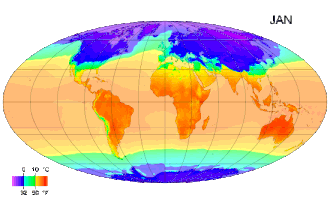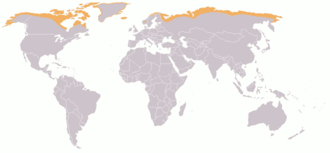CLIMATE
Climate is the pattern of variation in temperature, humidity,atmospheric pressure, wind, precipitation, atmospheric particle count and other meteorological variables in a given region over long periods. Climate can be contrasted to weather, which is the present condition of these variables over shorter periods.
A region's climate is generated by the climate system, which has five components: atmosphere, hydrosphere,cryosphere, land surface, and biosphere.[1]
The climate of a location is affected by its latitude, terrain, and altitude, as well as nearby water bodies and their currents. Climates can be classified according to the average and the typical ranges of different variables, most commonly temperature and precipitation. The most commonly used classification scheme was originally developed by Wladimir Köppen. The Thornthwaite system,[2] in use since 1948, incorporates evapotranspiration along with temperature and precipitation information and is used in studying animal species diversity and potential effects of climate changes. The Bergeron and Spatial Synoptic Classification systems focus on the origin of air masses that define the climate of a region.
Paleoclimatology is the study of ancient climates. Since direct observations of climate are not available before the 19th century, paleoclimates are inferred from proxy variables that include non-biotic evidence such as sediments found in lake beds and ice cores, and biotic evidence such as tree rings and coral. Climate models are mathematical models of past, present and future climates.Climate change may occur over long and short timescales from a variety of factors; recent warming is discussed in global warming
DefinitioN
Climate (from Ancient Greek klima, meaning inclination) is commonly defined as the weather averaged over a long period.[3] The standard averaging period is 30 years,[4] but other periods may be used depending on the purpose. Climate also includes statistics other than the average, such as the magnitudes of day-to-day or year-to-year variations. The Intergovernmental Panel on Climate Change (IPCC) glossary definition is as follows:
Climate in a narrow sense is usually defined as the "average weather," or more rigorously, as the statistical description in terms of the mean and variability of relevant quantities over a period ranging from months to thousands or millions of years. The classical period is 30 years, as defined by the World Meteorological Organization (WMO). These quantities are most often surface variables such as temperature, precipitation, and wind. Climate in a wider sense is the state, including a statistical description, of the climate system.[5]
The difference between climate and weather is usefully summarized by the popular phrase "Climate is what you expect, weather is what you get."[6] Overhistorical time spans there are a number of nearly constant variables that determine climate, including latitude, altitude, proportion of land to water, and proximity to oceans and mountains. These change only over periods of millions of years due to processes such as plate tectonics. Other climate determinants are more dynamic: the thermohaline circulation of the ocean leads to a 5 °C (9 °F) warming of the northern Atlantic Ocean compared to other ocean basins.[7] Other ocean currents redistribute heat between land and water on a more regional scale. The density and type of vegetation coverage affects solar heat absorption,[8] water retention, and rainfall on a regional level. Alterations in the quantity of atmospheric greenhouse gases determines the amount of solar energy retained by the planet, leading to global warming or global cooling. The variables which determine climate are numerous and the interactions complex, but there is general agreement that the broad outlines are understood, at least insofar as the determinants of historical climate change are concerned.
Climate classification
There are several ways to classify climates into similar regimes. Originally, climes were defined in Ancient Greece to describe the weather depending upon a location's latitude. Modern climate classification methods can be broadly divided into genetic methods, which focus on the causes of climate, and empiric methods, which focus on the effects of climate. Examples of genetic classification include methods based on the relative frequency of different air mass types or locations within synoptic weather disturbances. Examples of empiric classifications include climate zones defined by plant hardiness,[10] evapotranspiration,[11] or more generally theKöppen climate classification which was originally designed to identify the climates associated with certain biomes. A common shortcoming of these classification schemes is that they produce distinct boundaries between the zones they define, rather than the gradual transition of climate properties more common in nature
Thornthwaite[edit]
Devised by the American climatologist and geographer C. W. Thornthwaite, this climate classification method monitors the soil water budget using evapotranspiration.[11] It monitors the portion of total precipitation used to nourish vegetation over a certain area.[30] It uses indices such as a humidity index and an aridity index to determine an area's moisture regime based upon its average temperature, average rainfall, and average vegetation type.[31]The lower the value of the index in any given area, the drier the area is.
The moisture classification includes climatic classes with descriptors such as hyperhumid, humid, subhumid, subarid, semi-arid (values of −20 to −40), and arid (values below −40).[32]Humid regions experience more precipitation than evaporation each year, while arid regions experience greater evaporation than precipitation on an annual basis. A total of 33 percent of the Earth's landmass is considered either arid of semi-arid, including southwest North America, southwest South America, most of northern and a small part of southern Africa, southwest and portions of eastern Asia, as well as much of Australia.[33] Studies suggest that precipitation effectiveness (PE) within the Thornthwaite moisture index is overestimated in the summer and underestimated in the winter.[34] This index can be effectively used to determine the number of herbivore and mammal species numbers within a given area.[35]The index is also used in studies of climate change.[34]
Thermal classifications within the Thornthwaite scheme include microthermal, mesothermal, and megathermal regimes. A microthermal climate is one of low annual mean temperatures, generally between 0 °C (32 °F) and 14 °C (57 °F) which experiences short summers and has a potential evaporation between 14 centimetres (5.5 in) and 43 centimetres (17 in).[36] A mesothermal climate lacks persistent heat or persistent cold, with potential evaporation between 57 centimetres (22 in) and 114 centimetres (45 in).[37] A megathermal climate is one with persistent high temperatures and abundant rainfall, with potential annual evaporation in excess of 114 centimetres
Köppen
Main article: Köppen climate classification
The Köppen classification depends on average monthly values of temperature and precipitation. The most commonly used form of the Köppen classification has five primary types labeled A through E. These primary types are A, tropical; B, dry; C, mild mid-latitude; D, cold mid-latitude; and E, polar. The five primary classifications can be further divided into secondary classifications such as rain forest, monsoon, tropical savanna, humid subtropical,humid continental, oceanic climate, Mediterranean climate, steppe, subarctic climate,tundra, polar ice cap, and desert.
Rain forests are characterized by high rainfall, with definitions setting minimum normal annual rainfall between 1,750 millimetres (69 in) and 2,000 millimetres (79 in). Mean monthly temperatures exceed 18 °C (64 °F) during all months of the year.[15]
A monsoon is a seasonal prevailing wind which lasts for several months, ushering in a region's rainy season.[16] Regions within North America, South America, Sub-Saharan Africa, Australia and East Asia are monsoon regimes.[17]
A tropical savanna is a grassland biome located in semiarid to semi-humid climate regions of subtropical and tropical latitudes, with average temperatures remain at or above 18 °C(64 °F) year round and rainfall between 750 millimetres (30 in) and 1,270 millimetres (50 in) a year. They are widespread on Africa, and are found in India, the northern parts of South America, Malaysia, and Australia.[18]
The humid subtropical climate zone where winter rainfall (and sometimes snowfall) is associated with large storms that the westerlies steer from west to east. Most summer rainfall occurs during thunderstorms and from occasional tropical cyclones.[19] Humid subtropical climates lie on the east side continents, roughly between latitudes 20° and 40° degrees away from the equator.[20]
A humid continental climate is marked by variable weather patterns and a large seasonal temperature variance. Places with more than three months of average daily temperatures above 10 °C (50 °F) and a coldest month temperature below −3 °C (27 °F) and which do not meet the criteria for an arid or semiarid climate, are classified as continental.[21]
An oceanic climate is typically found along the west coasts at the middle latitudes of all the world's continents, and in southeastern Australia, and is accompanied by plentiful precipitation year round.[22]
The Mediterranean climate regime resembles the climate of the lands in theMediterranean Basin, parts of western North America, parts of Western and South Australia, in southwestern South Africa and in parts of central Chile. The climate is characterized by hot, dry summers and cool, wet winters.[23]
A steppe is a dry grassland with an annual temperature range in the summer of up to 40 °C (104 °F) and during the winter down to−40 °C (−40 °F).[24]
A subarctic climate has little precipitation,[25] and monthly temperatures which are above 10 °C (50 °F) for one to three months of the year, with permafrost in large parts of the area due to the cold winters. Winters within subarctic climates usually include up to six months of temperatures averaging below 0 °C (32 °F).[26]
Tundra occurs in the far Northern Hemisphere, north of the taiga belt, including vast areas of northern Russia and Canada.[27]
A polar ice cap, or polar ice sheet, is a high-latitude region of a planet or moon that is covered in ice. Ice caps form because high-latitude regions receive less energy as solar radiation from the sun than equatorial regions, resulting in lower surface temperatures.[28]
A desert is a landscape form or region that receives very little precipitation. Deserts usually have a large diurnal and seasonal temperature range, with high or low, depending on location daytime temperatures (in summer up to 45 °C or 113 °F), and low nighttime temperatures (in winter down to 0 °C or 32 °F) due to extremely low humidity. Many deserts are formed by rain shadows, as mountains block the path of moisture and precipitation to the desert.[29]





